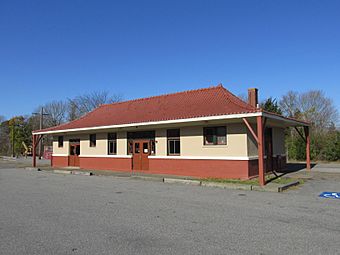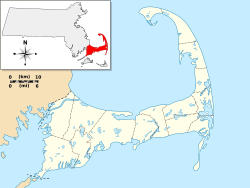West Barnstable Village–Meetinghouse Way Historic District facts for kids
Quick facts for kids |
|
|
West Barnstable Village–Meetinghouse Way Historic District
|
|

West Barnstable Train Station
|
|
| Location | Barnstable, Massachusetts |
|---|---|
| Area | 175 acres (71 ha) |
| Built | 1717 |
| Architectural style | Italianate, Federal |
| MPS | Barnstable MRA |
| NRHP reference No. | 87000255 |
| Added to NRHP | November 10, 1987 |
The West Barnstable Village–Meetinghouse Way Historic District is a special area in Barnstable, Massachusetts. It's like a time capsule that shows what the village of West Barnstable was like long ago. This district covers about 175 acres and includes many old buildings along Meetinghouse Way.
Most of the houses here were built in the 1700s and early 1800s. They show off old architectural styles like Georgian and Federal. Later buildings, like the First Selectmen's Office (1889), the elementary school (1903), and the train station (1910), are also part of this historic area. This district was added to the National Register of Historic Places in 1987, which means it's officially recognized as important to history.
Contents
Discovering the West Parish Meetinghouse
The West Parish Meetinghouse is the most important building in this historic district. It has a long and interesting story, starting way back in the 1700s.
Building a Community Hub
- 1712: The town of Barnstable was growing fast! People decided they needed to split into two areas, called "parishes," and build two new meetinghouses.
- 1715: A high spot on John Crocker's land was chosen for the West Parish Meetinghouse. They set aside four acres of land for public use, including where the building would stand.
- 1717: Barnstable officially divided into East and West Parishes. Construction began on the West Parish Meetinghouse. Local craftspeople used simple tools to build it. They cut down huge oak and pine trees, sawed beams, and shaped timbers by hand.
- 1719: After two years of work, the Meetinghouse was finished. The first church service was held on Thanksgiving Day. For the next 130 years, this building was used for both church services and important town meetings. It even housed the village school!
Changes and Famous Features
- 1723: Just four years after it was built, the Meetinghouse was already too small! They cut the building in half, pulled the ends apart, and added 18 feet to its length. A bell tower was also added. The famous gilded rooster weathervane, ordered from England, was placed on top. It's still there today!
- 1806: A half-ton bell was made by the famous Paul Revere for the town. It was given to the church to honor Colonel James Otis, a local hero. This bell still rings on Sunday mornings.
The Meetinghouse as a School
- 1717 to 1880s: The Meetinghouse served as a school for many years. Famous people like James Otis Jr. and Mercy Otis Warren, who were important during the American Revolution, were educated here.
- 1851: Rebecca Crocker, a student, drew a detailed picture of the Meetinghouse. It's the only known drawing from that time.
- Later 1800s: Reverend Henry Goodhue, the church pastor, started the first high school in Barnstable in the Meetinghouse's upstairs room. It was open to all students in town.
Remodeling and Restoration
- 1852: Instead of tearing down the old building, the West Parish decided to remodel the Meetinghouse. They changed its look to fit the popular style of the mid-1800s. A new spire and belfry were added, and windows and doors were changed. So much was altered that the original 1717 look was hidden.
- Early 1900s: The building started to fall apart because it no longer received public funding.
- 1929: Miss Samuel and Miss Elizabeth Crocker Jenkins started a "Restoration Fund" to save the Meetinghouse. They began raising money and working with architects to plan its restoration.
- 1935 to 1949: Miss Jenkins worked hard through tough times like the Great Depression and World War II to keep the restoration efforts going. She gave tours and used her own money to help.
- 1950s: The West Parish Memorial Foundation was formed to help with the restoration. They bought more land around the Meetinghouse.
- 1952: Jenkins Hall, a new building, was constructed so the church could meet there while the Meetinghouse was being restored.
- 1953: The Foundation officially took over the restoration project. Architects finalized plans to bring the Meetinghouse back to its original 1717 appearance. They used another old meetinghouse in New Hampshire as a guide, since no original drawings existed.
- 1958: The restoration was completed! A special service was held to celebrate. Over $133,000 was raised and spent to bring the historic building back to life.
The Meetinghouse Today
- 1960s to Present: The 1717 Meetinghouse is now considered one of the best examples of colonial architecture in the country. It's not just a museum; it's still an active church and a reminder of the people who built and cared for it over centuries.
- Open to Visitors: You can visit the 1717 Meetinghouse in the summer, from Memorial Day to Columbus Day, between 9 AM and 4 PM for self-guided tours. You can also arrange guided tours by appointment.
- Ongoing Care: The 1717 Meetinghouse Foundation (formerly West Parish Memorial Foundation) continues to care for the building. They make sure it stays in good condition, from painting the outside to updating security systems.
- 2013: The town of Barnstable helped by giving $275,000 for a new roof, a fire system, and to restore the historic Revere bell. The Foundation also changed its name to the 1717 Meetinghouse Foundation.




